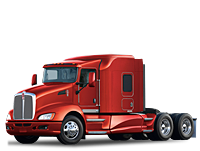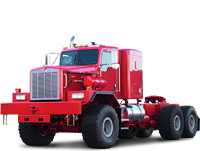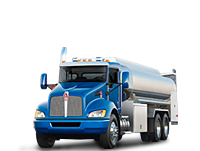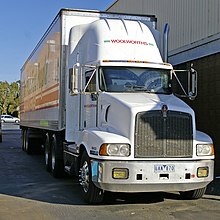
|
|
KENWORTH trucks, trailers and loads.


|
|
|
|
|
|
|
|

T880 - Class 8

T680 - Class 8

T680 Advantage - Class 8

T700 - Class 8

T660 - Class 8

W900 - Class 8

T800 - Class 8

C500 - Class 8

T470 - Class 7

T440 - Class 7

T370 - Class 7

T270 - Class 6

T170 - Class 5

K370 - Class 7

K270 - Class 6
|
|
Kenworth is an American and Australian manufacturer of medium and heavy-duty Class 8 trucks with its corporate office and engineering headquarters in Kirkland, Washington, United States, a suburb of Seattle, Washington. It is a subsidiary of Paccar, and is also a former manufacturer of transit buses and school buses.
Kenworth began its history in Portland, Oregon. In 1912, the company was founded by brothers George T. and Louis Gerlinger, Jr. as a car and truck dealership known as Gerlinger Motor Car Works. In 1914, they decided to build their own truck with a more powerful inline six-cylinder engine. This was the first ever put into a commercial truck. The Gersix, as it was known, unveiled in 1915, was framed in structural steel, which along with its power, made the truck ideal for the rugged Northwest,where it was used for logging.In 1916 the Gerlinger Motor Car Company moved to Tacoma, Washington. Seattle businessman Edgar K. Worthington was managing his mother's commercial building, where Gerlinger became a tenant, and became intrigued by the Gerlinger company. Worthington's tenant was doing quite well, or so it seemed, and the Gersix became a popular fixture in the Northwest. In 1917 Worthington and his business partner Captain Frederick Kent bought the Gerlinger business, renaming it the Gersix Motor Co.
In 1919 Kent retired from the business, and his son Harry Kent became Worthington's new partner. In 1922, Gersix made 53 trucks at its factory on Fairview Avenue at Valley Street. Under the new name, the company moved to 506 Mercer Street and later to 1263 Mercer Street. Trucks and motor coaches were assembled in individual bays rather than on a conventional assembly line.
In 1923 Kent and Worthington reincorporated the business as the Kenworth Motor Truck Company. The name was a combination of the two names "Ken" and "Worth", the same as the surname "Kenworth". In 1926 they started making buses, and in 1933 Kenworth was the first American company to offer diesel engines as standard in their trucks.In 1945 Kenworth was bought by The Pacific Car and Foundry Company.
The 1970s television series "Movin On " featured a Kenworth tractor.
In the 1989 James Bond movie Licence to Kill, James Bond drives a Kenworth W900 Semi-truck as he duels drug dealer Franz Sanchez. In Licence to Kill, the producers had 6 Kenworth Trucks rigged for stunt work, but they only used one for the stunt which 007 raised the front of truck to protect himself from a fire.
|
|
|
|
|
|
|
|
|
|
|
United States/CanadaAs of August 2016, North American Kenworth models include the T680 (60% of new sales), T880 (near 30%), T660, T800B and W900 (sharing the remaining ~10%)
As of November 2015, Kenworth's US and Canada product line includes:
- Class 8 Conventional
- W900, and its variants:
- W900B: extended Day Cab or AeroCab sleeper;
- W900L: long-cabin variant (130 inches long from bumper to back-of-cab);
- W900S: sloped hood;
- ICON900, a limited-edition premium version, introduced in 2015.
- T800, and its variants:
- T800H, a High Hood variant;
- T800W, which bears a wider grille, to accommodate a bigger radiator, for severe on-highway applications.
- T660 (Production will cease at the end of 2016 for year model 2017, due to the sales success of the T680)
- T680
- T880
- C500B (Off-Highway)
- Medium-Duty Conventional
- T470 (Class 7)
- T440 (Class 7)
- T370 (Class 7)
- T270 (Class 6)
- T170 (Class 5)
Medium-Duty Cabovers
- K370 (Class 7)
- K270 (Class 6)
Discontinued products
2013 Kenworth T700 tractor-trailer
- Class 8 Conventional
- T600/T600A/T600B (1985-2006, replaced by the T660)
- T450
- C850
- T700 (2011-2014, due to the sales success of the T680)
- T2000 (1996-2010, replaced by the T700)
- LW900
- W925 needle nose Like W900, with narrower grill-some with butterfly hoods. Production ended around 1962.
- Cabovers
- K100/K100E/K136E
- K184
- K330
- L700 (now Peterbilt 320)
- LCF (210)
- 993
Mexico
In the early 2000s Kenworth introduced to Mexico the T604, based on the Australian T604 with a few modifications, mostly in the hood.
Australia
Kenworth T650, used as a heavy vehicle tow truck
Australian models are assembled at Kenworth's Bayswater facility in Victoria, Australia. The first Kenworth model in Australia was the KWS925, imported fully built in 1962. Soon later, Kenworths were imported in complete knock-down kits and assembled in Preston, Victoria.
Popular models include the T600, T604, T609, T610, T610SAR, T650, W925, T900, T904, T908, T909, T950, T350, T400/T401/404S/T404ST/404SAR, K124, K100E, K100G, K104G, K104B, K200 (COE) and C500, C510, C540. With the T range being the Bonneted Models and the C for Heavy Haulage, Mine, Off road and Road Train use and the K range being the Cab over models. Several "Twin Steer" Models were produced through the end of the 20th Century. Most notably was the K100E Twin Steer.
Kenworth Australia have started building the new range of trucks tying in their 2008 Release with the model range being the '08 Series'. This includes the following conventional (bonneted) models; in approximate order of smallest to largest: the T358/A, T408SAR, T408, T608, T658, T908, C508, C510. The only Cabover truck built is the K108, which is very popular in the B-Double market segment owing to its shorter length

































































